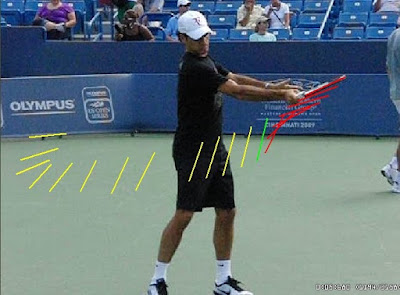Yeah!!! Why is tennis so F-in HARD?
–because almost all coaches do not tell you the spare essentials of practically every very good contemporary (male?) forehand. JY is inclined to say "don't get hung up on the backswing loop stuff" or "there is no wrist snap." I agree with both. However, I think it is important to learn early:
-that the racquet position on take-back should be such that, loop or no loop, ESR (some do it in the loop, most do it on first forward motion) will put the wrist into nearly full lag, and that the slight push of the grip outward toward your intended contact point will complete the lag to the farthest extent possible.
-That the hitting upper arm should be raised far enough from the side during take-back (watch your favorite pro from Sampras to Rafa to Fed) to assure some locking at the shoulder...so that when the UB starts rotating the upper hitting arm will come along.
-That the wrist stays back through to contact, unless you have to reach outward for the ball, in which case you go to a wrist locked in its actual primary lock position. (What? Hold your hand in front of you, straight fingers, whole hand inline with forearm. Make a fist suddenly with a hard squeeze. If you have a normal wrist you'll find it bends back about 45º and is immovable until you WANT it to move forward for adjustment.
-That learning to actively use ISR up into and through contact is one of the spare essentials of the contemporary forehand. Though a know-nothing observer may think you're using "wristiness" into contact, you are not. ISR naturally turns your wrist up powerfully and alters orientation, so that the racquet is forced 1)upward in the plane of the string-bed; 2)forward in the direction of the hit; 3) and into some slight forward tilt, a second boost to your topspin.
ALL the rest about the hitting arm/hand path strikes me as useless mumbo jumbo, if these elements are not there. If they are there, you won't be fishing around for alternative explanations as to what pros do. These alternatives, if they leave out the above, will generally be wrong, leading to error.
Four spare essentials does not seem to much. The "separation angle" on turn-back is well covered elsewhere, as is use of the off-arm. The Japanese coaches say "always return to fundamentals." I think those four bullet points cover them, taken together with "coiling back" and the means to launch torso rotation. Well, there. I've had my say.
Last edited:



















